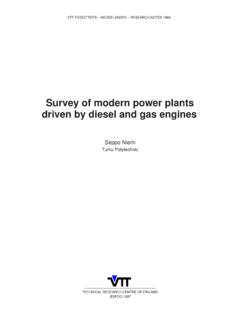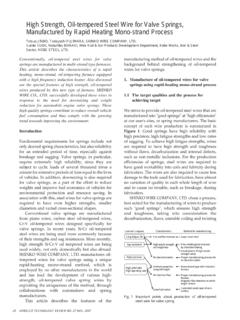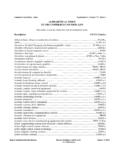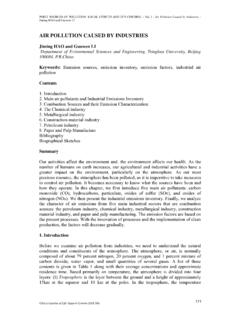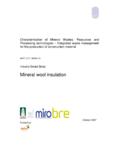Transcription of Improved durability and reduced system complexity of solid ...
1 Improved durability and reduced system complexity of solid oxide fuel cell systems solid oxide fuel cells (SOFCs) are electrochemical devices that produce electricity (and heat) from fuel and air. They are expected to play an important role in the power generation sector due to their advantages in terms of high electrical efficiency, modularity, fuel flexibility and very low emissions. However, their high cost remains a burden, delaying their market entry. In order to drive their cost down, their durability must be Improved and the system complexity needs to be reduced . This dissertation addresses these challenges through the development of solutions to reduce the degradation of SOFCs because of chromium poisoning of the cathode. In addition, simplification of the fuel processing subsystem are investigated and demonstrated. Lastly, performant and durable sealing solutions were developed and tested in an operating SOFC stack.
2 ISBN 978-951-38-8360-7 (Soft back ed.) ISBN 978-951-38-8361-4 (URL: ) ISSN-L 2242-119X ISSN 2242-119X (Print) ISSN 2242-1203 (Online) :ISBN:978-951-38-8361-4 VTT SCIENCE 112 Improved durability and reduced system complexity VISIONS SCIENCE TECHNOLOGY RESEARCHHIGHLIGHTS Dissertation 112 Improved durability and reduced system complexity of solid oxide fuel cell systems Olivier Thomann VTT SCIENCE 112 Improved durability and reduced system complexity of solid oxide fuel cell systems Olivier Thomann A doctoral dissertation completed for the degree of Doctor of Science (Technology) to be defended, with the permission of the Aalto University School of Science, at a public examination held in the auditorium K213 at Aalto University on 09 December 2015 at 12 noon. ISBN 978-951-38-8360-7 (Soft back ed.) ISBN 978-951-38-8361-4 (URL: ) VTT Science 112 ISSN-L 2242-119X ISSN 2242-119X (Print) ISSN 2242-1203 (Online) :ISBN:978-951-38-8361-4 Copyright VTT 2015 JULKAISIJA UTGIVARE PUBLISHER Teknologian tutkimuskeskus VTT Oy PL 1000 (Tekniikantie 4 A, Espoo) 02044 VTT Puh.
3 020 722 111, faksi 020 722 7001 Teknologiska forskningscentralen VTT Ab PB 1000 (Teknikv gen 4 A, Esbo) FI-02044 VTT Tfn +358 20 722 111, telefax +358 20 722 7001 VTT Technical Research Centre of Finland Ltd Box 1000 (Tekniikantie 4 A, Espoo) FI-02044 VTT, Finland Tel. +358 20 722 111, fax +358 20 722 7001 Cover image: Olivier Thomann, 2012 Juvenes Print, Tampere 2015 3 AbstractSolid oxide fuel cells (SOFCs) show great potential for clean and efficient powergeneration applications. However, their high cost is preventing their market dissertation focuses on solutions to increase the durability of SOFCs and toreduce the complexity of SOFC systems to drive their cost poisoning of the cathode is a major issue limiting the durability ofSOFCs. This issue is addressed by the development of a protective manganese-cobalt spinel coating for steel interconnects. Coated interconnects were character-ised in SOFC relevant conditions and the results showed that the coating fulfilledits main requirements, which are: limitation of chromium transport from the inter-connect to the cathode, protection against oxidation of the steel and low and sta-ble area-specific resistance.
4 Evidence was found that another source of chromiumis the balance-of-plant (BoP) components upstream of the cathode, an issuewhich did not receive much attention in the literature. Therefore, a method formeasuring chromium evaporation from BoP components was developed andvalidated on a stainless steel systems based on natural gas commonly include a fuel processing sub- system for fuel steam reforming. The need for an external water source can beeliminating by recycling the steam-rich anode off-gas. Investigations were per-formed on a pre-reformer with a precious metal catalyst and it was found thatadding an anode off-gas recycling loop had no detrimental effect on the activity ofthe catalyst and carbon formation could be avoided. Additionally, results showedthe possibility to generate the hydrogen-containing gas needed to prevent thereoxidation of the anode catalyst during heat-up phase.
5 The results permitted theimplementation of an anode off-gas recycling loop in a 10 kW SOFC system . Addi-tionally, the system was heated up without supplying any premixed hydrogen-containing gas, which enables to reduce the complexity of the , the durability of a stack can be Improved by seal solutions with limitedmaterial interactions. A hybrid seal solution was developed by coating a com-pressible core with glass layers. The developed seal reduced the leak rate com-pared to a purely compressible seal. Material interactions were studied with apost-experimental investigation of an SOFC stack. Interactions were limited withthe exception of evidence of increased oxidation at the steel/seal/air , the solution was found to be promising and the obtained results led to thecommercialisation of the developed seal solution by Flexitallic Ltd (UK) [1].
6 Keywords: fuel cells, SOFC, chromium poisoning, anode off-gas recycling, sys-tem heat-up, seal, interconnect, material interactions5 PrefaceThe work presented here has been carried out between 2010 and 2015 at VTTT echnical Research Centre of Finland Ltd under the supervision of ProfessorPeter Lund from Aalto University. I would like to acknowledge financial supportfrom VTT Technical Research Centre of Finland Ltd, the fuel Cells and HydrogenJoint Undertaking and Tekes the Finnish Funding Agency for am very thankful to my instructors, D. Sc Jari Kiviaho and D. Sc Olli have been of great support during this work and I enjoyed to have the oppor-tunity to perform exciting research in a motivating environment. I am also gratefulto Professor Peter Lund for the efficient , I would like to thank D. Sc Markus Rautanen, D. Sc Matias Ha-linen, D. Sc Mikko Pihlatie, M.
7 Sc Johan Tallgren, D. Sc Andreas Schuler, D. ScPekka Simell and M. Sc Risto Parikka. Our collaboration was absolutely essentialto the realization of this , I would like to express my gratitude to Kari Koskela, Juha J rvinen,Jorma Stick and Kai Nurminen. Without your practical, creative and efficient work,this work would have lasted decades. I thank also Kaija Luomanper and P iviJokimies for the gas friends I made in Otaniemi were also of essential support to take my mindoff my work when it was needed. Many thanks to Raphael, Florence, Micha , Emileand would like to thank Tuisku for her continuous support during the up and thedown of this adventure. Lastly, a big thank for my family, particularly to my par-ents, Catherine and Matthias and to my grandparents, Leni and Hans, who weregreat support for my education and during my doctoral , August 2015 Olivier Thomann6 Academic dissertationSupervisingprofessorProfesso r Peter LundDepartment of Applied PhysicsAalto University School of ScienceEspoo, FinlandThesisadvisorsDoctor Jari KiviahoFuel Cells and HydrogenSmart Industry and Energy SystemsVTT Technical Research Centre of Finland LtdEspoo, FinlandDoctor Olli HimanenFuel Cells and HydrogenSmart Industry and Energy SystemsVTT Technical Research Centre of Finland LtdEspoo, FinlandPreliminaryexaminersProfessor Anke HagenDepartment of Energy Conversion and StorageTechnical University of DenmarkRoskilde, DenmarkDoctor Magali ReytierHydrogen Production LaboratoryFrench Alternative Energies and Atomic Energy CommisionGrenoble.
8 FranceOpponentProfessor Massimo SantarelliDENERG -Dipartimento EnergiaPolitecnico di TorinoTorino, Italy7 List of publicationsThis dissertation is based on the following original publications which are referredto in the text as Publications I VI. The publications are reproduced with kind per-mission from the Thomann, O., Pihlatie, M., Rautanen, M., Himanen, O., Lagerbom, J.,M kinen, M., Varis, T., Suhonen, T. & Kiviaho, J. Development and ap-plication of HVOF sprayed spinel protective coating for SOFC intercon-nects. Journal of Thermal Spray Technology 2013, Vol. 22, No. 5, Thomann, O., Pihlatie, M., Schuler, , Himanen, O. & Kiviaho, for measuring chromium evaporation from SOFC balance-of-plant components. Electrochemical and solid -State Letters 2012, Vol. 15,No. 3, pp. B35 Halinen, M., Thomann, O. & Kiviaho, J. Effect of anode off-gas recyclingon reforming of natural gas for solid oxide fuel cell systems.
9 fuel Cells2012, Vol. 12, No. 5, pp. 754 Halinen, M., Thomann, O. & Kiviaho, J. Experimental study of SOFC sys-tem heat-up without safety gases. International Journal of Hydrogen En-ergy 2014, Vol. 39, No. 1, pp. 552 Rautanen, M., Thomann, O., Himanen, O., Tallgren, J. & Kiviaho, coated compressible solid oxide fuel cell seals. Journal of PowerSources 2014, Vol. 247, pp. 243 Thomann, O., Rautanen, M., Himanen, O., Tallgren, J. & Kiviaho, J. Post-experimental analysis of a solid oxide fuel cell stack using hybrid of Power Sources 2015, Vol. 274, pp. 1009 description of the content of the publicationsPublication I: Protective coatings were applied on interconnect steel material byhigh velocity oxy- fuel spraying. The coated substrates were tested in long-termexposure tests to assess their high-temperature oxidation behaviour.
10 Conductivitymeasurement showed that the coated substrate area-specific resistance wasstable over time. Additionally, coated interconnect was used in a stack for 6000hours and post-experimental analysis showed that the coating protected the inter-connect from oxidation and exhibited adequate chromium II: A method for measuring chromium evaporation from balance-of-plant components was developed. The volatile chromium was collected by airsampling through a denuder tube coated with sodium carbonate. Identification ofthe source of volatile chromium in an SOFC system is crucial for designing strate-gies to protect the cathode from chromium III: The article focuses on the effect of anode off-gas recycling onthe performance of a natural gas pre-reformer. Two scenarios were compared:one in which the pre-reformer was fed with a gas composition corresponding tothe one found in an SOFC system equipped with an anode-off gas recirculationloop, and another corresponding to a system operated with steam-reformed natu-ral gas.


